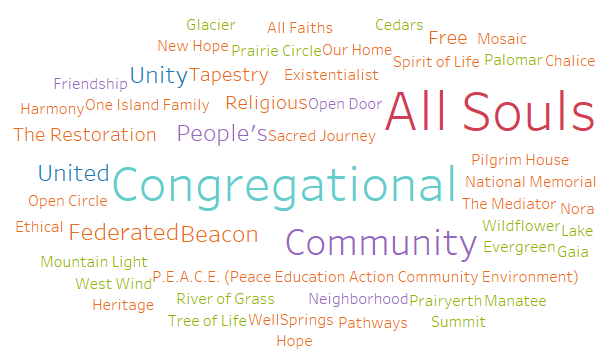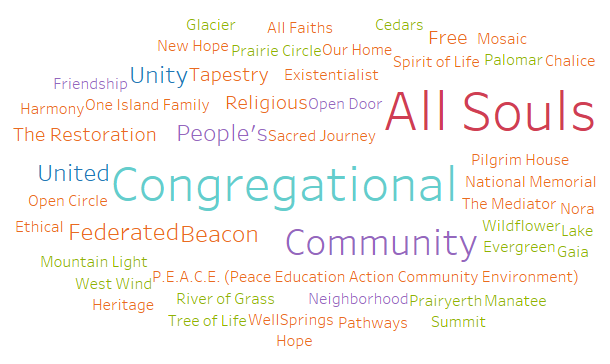Daniel Sturtevant has taken a close look at the names of other UU congregations, and he gives us this (really great!) analysis.
“What should the name of a congregation express about itself?”
Names of UU Congregations

Now that we have decided to find a new name for our congregation, let’s see what the rest of our movement has chosen.
I’ve identified various categories to help us think about this. These categories often overlap, and the boundaries between them are imprecise. My goal is not to encapsulate the one true interpretation of UU congregation names, but to draw the best shapes I can around clusters of similarity. Hopefully, this will help give us a picture of what others have tried before us. So, if you think you have a different idea about how something should have been classified – yeah, that’s probably valid.
I have compiled these visualizations using data provided by request from the UUA on January 2, 2020. Things may have changed since then. Information on current UUA member congregations can be found here: https://my.uua.org/directory
UU Congregations are Mostly Named for their Location

The immediate takeaway from looking at the names as a whole is that most UU congregations are named for where they are, and often not much else. These names include cities, towns, streets, counties, regions, and geographical and natural features. 852 congregations are named exclusively for their location, and 33 more combine the name of the location with something else such as a concept or a person.
Many of these names don’t communicate much substance beyond the location: First Unitarian Church of Louisville or UU Society: East. Others were lucky, deliberate, or both in using location names that include some poetry or additional evocation of meaning. Here are a few that stand out to me:

There are some pretty good reasons we might not want to use our location for our name, and many of these reasons are why we didn’t do that in 1960.
-
Louisville is part of First Church’s name, and we get into the confusing question of deciding if we are second or third or possibly some other number.
-
We could be named after Brownsboro Road, but Brownsboro is a small town in Oldham County where the road eventually leads.
-
Being in Jefferson County (part of the original reason for choosing the name Thomas Jefferson) won’t help.
-
Most other locations of the church either suggest exclusion (East End) or are somewhat broad (Kentucky, Earth etc.).
So, what’s left in that other 17%?
The 1.4% labelled “[None]” in the previous chart are congregations don’t really have anything besides one “U” or both and something like “Church”. For instance, The UU Church, UU Society, The Unitarian Society: A UU Congregation, or similar. Speaking exclusively for myself, I think we can probably aspire to have a more interesting name than these.
UU Congregations Named After People

There are several UU congregations named after people. Prominent American UU’s are the majority.
(Fun one I think is worth highlighting: the church named after Thoreau is called Thoreau Woods UU Church)
Many in this conversation have pointed out that one lesson of our times is that as our moral standards gradually shift ever further in the direction of greater justice, we will expect that no individual’s legacy will continue to live up to these standards indefinitely. For this reason, we might want to avoid naming the congregation after a person either.
That leaves the remaining names, which I have above categorized all together as Concepts. Let’s take a closer look at this 12.2%
Congregations Named After Concepts

What I have labelled “Numeration” is the naming convention of, for instance, First Unitarian Church of Louisville, Second Congregational Meeting House Society UU, or Fourth UU Congregation of Westchester County, NY. There are 197 congregations who use numeration in their name, 20 of which use nothing but numeration (no location, concept, etc.; just something like “church”).
Among what’s left, two names stand out reflecting different parts of American UU heritage. The name All Souls is a very common Universalist name calling up the concept of universal salvation for all souls, and having Congregational as part of a name is especially common in New England, where many UU churches were previously part of the Congregational Church before joining up with one U or the other.
Here are the concepts used in all UU congregation names excluding locations and those named only by numeration:

The next question we might consider as part of the naming question would be the “Church” part. For lack of a better term for this part of the name, I’ve been calling it the Noun (which is not to say that the other part of the name won’t be a noun, but I need to call it something, so…). UU congregations offer a lot of different options, with less than half of UU congregations having “Church” in their name.
In the classification here, “UUs” refers to the practice of not having a word like church, but instead having “Unitarian Universalists,” “Unitarian Universalist” or something like that as part of the name. Examples include Sierra Foothills Unitarian Universalists and Two Rivers Unitarian Universalist. The category “All Souls” as used here is similar, referring to a couple of churches where the entire name is “All Souls” plus a location: All Souls Miami and All Souls Waccamaw.
“Combinations” refers to a few who use more than one of the other Nouns at once, such as Wildflower Church: a UU Congregation and First Unitarian Church and Society of Barnard.
The Noun in the Name


